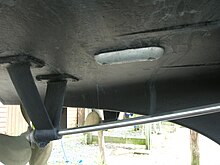Cathodic protection (CP; /kæˈθɒdɪk/ (listen)) is a technique used to control the corrosion of a metal surface by making it the cathode of an electrochemical cell.[1] A simple method of protection connects the metal to be protected to a more easily corroded "sacrificial metal" to act as the anode. The sacrificial metal then corrodes instead of the protected metal. For structures such as long pipelines, where passive galvanic cathodic protection is not adequate, an external DC electrical power source is used to provide sufficient current.
Cathodic protection systems protect a wide range of metallic structures in various environments. Common applications are: steel water or fuel pipelines and steel storage tanks such as home water heaters; steel pier piles; ship and boat hulls; offshore oil platforms and onshore oil well casings; offshore wind farm foundations and metal reinforcement bars in concrete buildings and structures. Another common application is in galvanized steel, in which a sacrificial coating of zinc on steel parts protects them from rust.
Cathodic protection can, in some cases, prevent stress corrosion cracking.
https://en.wikipedia.org/wiki/Cathodic_protection


No comments:
Post a Comment